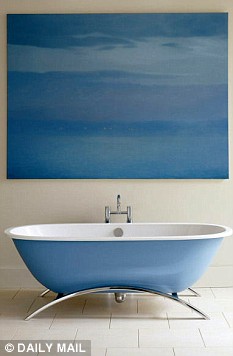Colour blue boosts creativity, say scientists unlocking secrets of the spectrum
By David Derbyshire
Last updated at 7:48 AM on 06th February 2009
Installing blue furniture and objects in the house may lead to increased creativity and risk-taking
Being surrounded by blue makes us more imaginative, scientists believe.
The colour has long been associated with creating a sense of calm but now it appears there are extra benefits to be had from blue walls and furniture.
In such conditions, a Canadian study found, volunteers for a series of tests came up with more creative ideas and took more risks.
Red, on the other hand, made them concentrate more - suggesting it can help with the absorption of complex information or revising for exams.
The researchers who made the discovery say it could have implications for everything from the colour of warning labels on drug packets, to the design of offices, classrooms and street signs.
The study, published in the journal Science, looked at the impact of red and blue on a team carrying out mental tasks such as solving anagrams, memorising word lists and designing toys for children.
Over six experiments, the researchers found that red - the colour often associated with danger, warnings and mistakes - made volunteers more vigilant and more wary about taking risks.
In contrast, blue - which is associated with openness, peace and tranquillity - made them take more risks, the scientists from the University of British Columbia found.
Many of the experiments were performed on computers, with up to 161 volunteers solving problems in front of a either a blue, red or neutral background.
In one, 42 volunteers were given a sheet of paper with drawings of 20 different parts and told to use five of them to design a children's toy.

Red - commonly associated with warning signs - was said to aid concentration
'Toys designed by those in the red colour condition were judged to be more practical and appropriate than those in the blue condition, but were judged less original and novel than those in blue condition,' said Dr Rui Zhu, who led the study.
The researchers believe that people learn to associate particular colours with different states of mind - and that their affects could vary from culture to culture.
'Results from this research suggest that, depending on the nature of the task, different colours might be beneficial,' they wrote.
'If the task on hand requires people's vigilant attention - for example memorising important information or understanding the side effect of a new drug - then red... might be particularly appropriate.
'However, if the task calls for creativity and imagination - for example designing an art shop or a new product idea brainstorming session - then blue...would be more beneficial.'
Interior designers have long used colours to influence mood. Hospitals, for instance, are traditionally painted in calming greens and blues, while fast food restaurants use aggressive reds to encourage quicker eating.
Source: http://www.dailymail.co.uk/sciencetech/article-1136922/Colour-blue-boosts-creativity-say-scientists-unlocking-secrets-spectrum.html
